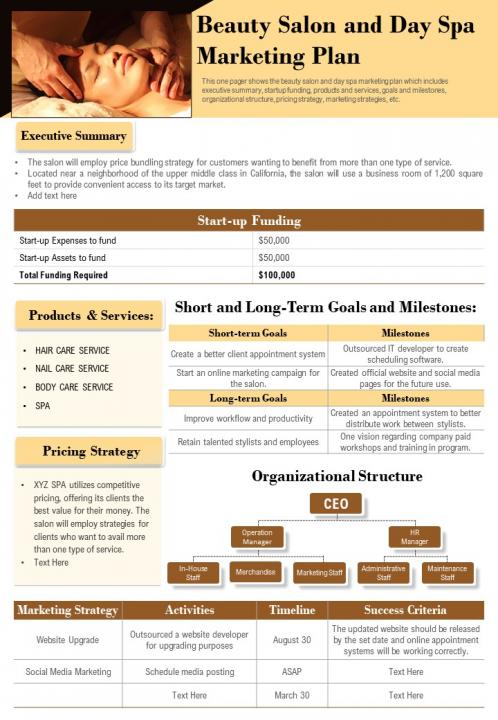Unveiling the secrets: Discover the foolproof steps to skyrocket your salon’s success using an unbeatable marketing strategy.

Image courtesy of Pixabay via Pexels
Table of Contents
As a salon owner, you understand that the success of your business relies heavily on attracting and retaining customers. But how do you make sure you stand out from the competition and effectively promote your services? The answer lies in developing a winning marketing strategy.
In this ultimate guide, we will delve into the various steps involved in creating a marketing strategy specifically tailored for salon owners. By following these guidelines, you will be equipped with the knowledge and tools to elevate your salon’s brand, attract more customers, and ultimately achieve greater success.
Defining Your Target Audience
Before diving headfirst into marketing tactics, it is crucial to have a clear understanding of your target audience. By identifying your ideal customers’ demographics and psychographics, you can tailor your marketing efforts to meet their specific needs and preferences.
Start by analyzing your current customer base and identifying common characteristics among them. Are they predominantly male or female? What is their age range? Additionally, consider their interests, lifestyle choices, and pain points related to salon services.
Once you have a comprehensive understanding of your target audience, you can better tailor your marketing messages, promotions, and services to appeal specifically to them.
Setting Goals and Objectives
Setting clear and measurable goals is an essential step in developing an effective marketing strategy. Without concrete objectives, it becomes challenging to track your progress and determine the success of your efforts.
First, establish overarching goals for your marketing activities. These goals could include increasing bookings, boosting revenue, enhancing brand awareness, or even introducing new services. The key is to have a clear direction for your marketing efforts.
Next, break down these goals into specific objectives that can be measured and tracked. For example, if your goal is to increase bookings, your objectives might include improving the conversion rate of website visitors to bookings or increasing repeat visits from existing customers.
By setting both macro and micro objectives, you create a roadmap for your marketing activities and ensure you stay on track towards achieving your salon’s overarching goals.
Conducting Market Research
Market research is a fundamental aspect of developing a successful marketing strategy for your salon. By analyzing the competition, identifying market trends, and gathering customer feedback, you gain valuable insights that drive your marketing decisions.

Image courtesy of www.kitomba.com via Google Images
Begin by researching your competitors. Take a close look at their offerings, pricing, marketing tactics, and target audience. This analysis will help you identify gaps in the market and potential areas for differentiation.
Additionally, stay informed about the latest trends in the salon industry. Are there any emerging techniques, services, or technologies that could be incorporated into your salon’s strategy? By staying ahead of the curve, you position your salon as a leader in the industry.
Lastly, gather feedback from your existing customers. Conduct surveys, engage in direct conversations, and monitor online reviews to understand their level of satisfaction and areas for improvement. This valuable feedback will help you tailor your marketing messages and improve your salon’s overall customer experience.
Building Your Brand Identity
In a competitive industry like the salon business, it is crucial to develop a strong and distinctive brand identity. Your brand should resonate with your target audience and set your salon apart from the competition.
Start by defining your salon’s unique selling proposition (USP). What makes your salon different from others? Is it your personalized approach, expertise in a specific technique, or use of high-quality products? Once you determine your USP, make it a core element of your branding strategy.
Develop a visually appealing and consistent brand identity that reflects your salon’s values and appeal to your target audience. This includes creating a memorable logo, choosing a color palette, and defining your salon’s overall aesthetic. Consistency in visual elements across different marketing platforms helps build recognition and reinforces your brand’s presence.
Moreover, your brand identity extends beyond visual aspects. Craft compelling messaging that communicates your unique selling points, appeals to your target audience, and highlights the benefits of your salon’s services. Incorporate this messaging across various touchpoints, including your website, social media, and promotional materials.
Creating a Marketing Plan
With a solid understanding of your target audience, goals, and brand identity, you are now ready to create a comprehensive marketing plan. Your marketing plan should outline the various channels and tactics you will utilize to promote your salon and engage with your target audience.

Image courtesy of www.slideteam.net via Google Images
Consider a mix of both online and offline marketing strategies to reach a wider audience. Establish a professional and user-friendly website that showcases your salon’s services, expertise, and testimonials. Engage with your customers through social media platforms where you can share before-and-after pictures, feature client success stories, and announce promotions or events.
Email marketing is another effective tool for staying connected with your existing and potential customers. Collect email addresses through your website or salon’s physical location and send out regular newsletters with updates, special offers, and industry insights.
Furthermore, explore local partnerships to broaden your reach. Collaborate with complementary businesses, such as bridal boutiques or wellness centers, to cross-promote each other’s services. Participate in community events and sponsor local initiatives to establish your salon as an active contributor to the community.
Implementing and Monitoring Your Strategy
Execution and monitoring are two essential elements of any marketing strategy. Start by implementing your marketing plan effectively and consistently. Be proactive in executing planned tactics, maintaining brand consistency, and engaging with your target audience.
As you roll out your marketing activities, track and measure key performance indicators (KPIs) to assess the effectiveness of your strategy. This could include monitoring return on investment (ROI), website traffic, social media engagement, customer acquisition, and email campaign performance.
Incorporate these metrics into regular reports or dashboards to visualize your progress. Identify areas where adjustments or optimizations may be necessary to improve results. Regularly review and reassess your marketing activities based on data, customer feedback, and market trends.
Establishing Customer Loyalty Programs
Retaining existing customers is just as important as attracting new ones. Implementing customer loyalty programs is an effective way to reward your loyal clients, encourage repeat business, and increase customer lifetime value.

Image courtesy of www.slideshare.net via Google Images
Consider implementing a points-based system where customers earn rewards for frequent visits or referrals. Offer exclusive promotions or discounts to your loyal customers and ensure they feel appreciated and valued.
Furthermore, encourage your satisfied customers to leave positive reviews on platforms like Google, Yelp, or social media. Positive reviews help boost your salon’s reputation and serve as valuable social proof to attract and convert potential customers.
Embracing Online Reviews and Reputation Management
In today’s digital age, online reviews can make or break a salon’s reputation. It is crucial to regularly monitor and respond to customer reviews to build trust and maintain a positive online presence.
Regularly check platforms where customers can leave reviews about your salon. Respond promptly and professionally to both positive and negative reviews. Express gratitude for positive feedback, address concerns or issues raised in negative reviews, and seek resolutions whenever possible.
By actively engaging with customers through online reviews, you demonstrate your commitment to customer satisfaction and establish a positive image for your salon.
Conclusion
Developing a winning marketing strategy holds the potential to make a significant difference in the success of your salon. By defining your target audience, setting goals, conducting market research, building a strong brand identity, creating a comprehensive marketing plan, and implementing and monitoring your strategy, you position your salon for growth and success.
Remember, marketing is an ongoing process. As the industry evolves and consumer preferences change, embrace creativity, experimentation, and adaptability. Celebrate successes and learn from failures, continually refining your marketing approach to ensure your salon’s continuous growth and prosperity.